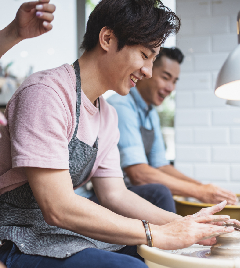A gastroscopy is an examination of the upper part of the gastrointestinal tract - the oesophagus (gullet), stomach and duodenum (the first part of the small intestine). This is done using a flexible, tube-like telescope called an endoscope, which is about the thickness of a little finger. The endoscope is passed through the mouth and into the oesophagus. The procedure may also be simply referred to as an endoscopy.
A gastroscopy is useful for finding out what is causing your symptoms, or as a check-up for certain gastrointestinal conditions. During the procedure, the doctor may take a biopsy - a sample of the lining of the gullet, stomach or duodenum - for examination in the laboratory.
Gastroscopy is routinely performed as an outpatient or day case, requiring no overnight stay in hospital. A general anaesthetic is not generally required, but you may be given a sedative to help ensure that you are relaxed and comfortable.
About the procedure
A gastroscopy usually takes about 10-15 minutes. The procedure will not hurt but may feel uncomfortable to begin with. As the endoscope passes through your oesophagus, and not the trachea (windpipe), you will be able to breathe normally throughout the procedure.
Preparing for the procedure
For the doctor to get a clear view through the endoscope, the stomach needs to be empty. To achieve this, you will need to avoid eating for three to four hours before the test but can sip clear fluids for up to two hours before the test.
Sedation and pain relief
Modern endoscopes are thin and quite easy to swallow. The doctor may spray a local anaesthetic into the back of your throat or give you a lozenge to suck to numb the throat area.
In some cases, you and your doctor may decide that you need a sedative. Your doctor will explain what to expect, but it generally involves an injection into a vein in the back of the hand. Almost immediately, this will make you feel relaxed and drowsy.
Risks of gastroscopy
Gastroscopy is a very commonly performed and generally safe procedure. For most people, the benefits of having a clear diagnosis, or quick and effective treatment are much greater than any disadvantages. However, like all invasive medical procedures, there are some risks. These can be divided into the risk of side-effects and the risk of complications.
Side-effects
These are the unwanted, but usually mild and temporary, effects of a successful procedure. After a gastroscopy, you may feel bloated, but this usually clears up quite quickly. If you have a sedative, it may make you feel sleepy.
Complications
Your doctor will be very experienced at performing endoscopies but, even so, a few are not successfully completed and may need to be repeated.
Other complications are uncommon, but it is possible for the oesophagus, stomach or intestine to be damaged or, in rare and extreme cases, perforated during the procedure. This can lead to bleeding and infection, which may require treatment with medicines or surgery.
The chance of complications depends on the exact type of procedure you are having and other factors such as your general health. You should ask your specialist to explain how these risks apply to you.
What to expect
If a sedative has been given, the procedure will not start until it has taken effect. With you resting comfortably on your side, on a bed or examining couch, the endoscope will be carefully inserted into your mouth. The natural swallowing action will help the endoscope pass into the gullet and down towards the stomach.
Air will be passed through the tube and into the stomach to make the lining easier to see. When this happens, you may briefly feel a sensation of fullness or nausea. At the end of the endoscope, a tiny light and lens enable the doctor to see if any disease is present. If necessary, the doctor will take a small biopsy of tissue for analysis. This is a quick and painless process, using specialist instruments that can be passed inside the endoscope.
When the examination is finished, the endoscope is removed quickly and easily.
After the gastroscopy
You will rest in a full-length chair or on a bed for about half an hour, or longer if you've had a sedative.
The effects of any sedative may last longer than you expect, so you should not drive, operate machinery or drink alcohol for 24 hours after your examination. This means that you will have to arrange for someone to take you home and stay with you for the first day.
Once home, it's sensible to take it easy for the next 24 hours. Most patients feel able to resume normal activities on the following day.
Disclaimer
This information was published by Bupa Group's Health Content Team and has been reviewed by appropriate medical or clinical professionals. To the best of their knowledge the information is current and based on reputable sources of medical evidence, however Bupa (Asia) Limited makes no representation or warranty as to the completeness or accuracy of the Content.
The information on this page, and any information on third party websites referred to on this page, is provided as a guide only. It should not be relied upon as a substitute for professional medical advice, nor is it intended to be used for medical diagnosis or treatment. Bupa (Asia) Limited is not liable for any loss or damage you suffer arising out of the use of, or reliance on, the information.
Third party websites are not owned or controlled by Bupa and any individual may be able to access and post messages on them. Bupa is not responsible for the content or availability of these third party websites. Last updated August 2017.










